If you know your coin basics, you’ll know that coins minted in the same year are distinguishable by their mint mark. But did you know that for the 1960 penny, the size of the date on the obverse matters too?
Philadelphia and Denver both produced pennies in 1960. Each issue had two types of dates—small and large. How does this affect the value of the 1960 penny? What errors are common in these varieties? We’ll answer these questions and more in this guide.
1960 Penny Value Details
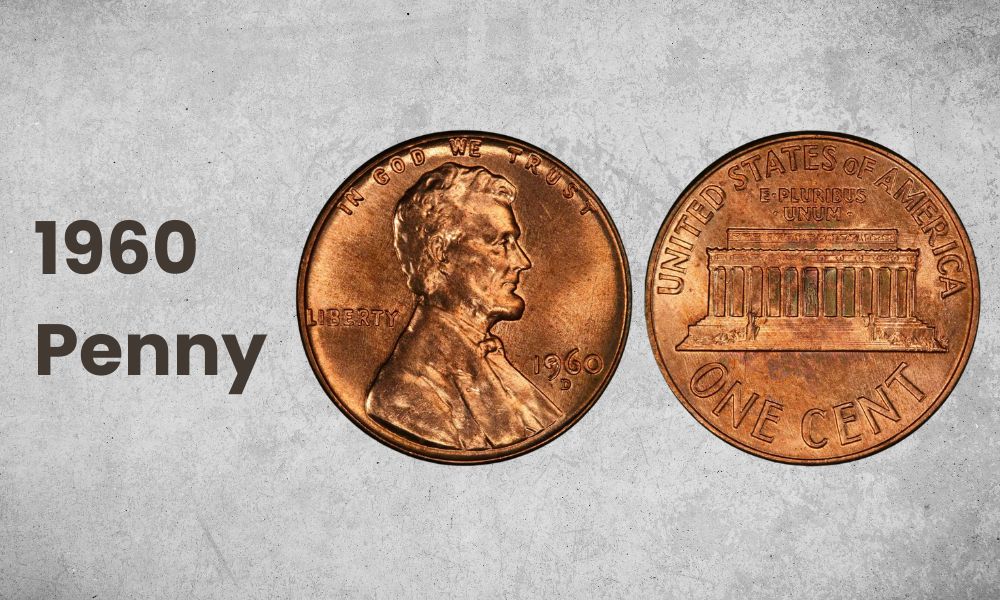
- Category: Lincoln Memorial Cents
- Mints: Philadelphia and Denver
- Total mintage: 2,167,289,000
- Obverse designer: Victor D. Brenner
- Reverse designer: Frank Gasparro
- Edge: Plain
- Diameter: 19 mm
- Content: 95% copper, 5% tin and zinc
- Weight: 3.11 grams
The 1960 penny has the same obverse as Victor Brenner’s famous Lincoln wheat penny born in 1909. You’ll see Abraham Lincoln on the face of the coin, his profile facing right.
On the upper rim of the obverse are the words “In God We Trust. On Lincoln’s left side, the word “Liberty” is engraved. And on the right, the year 1960 is struck.
But the reverse of the 1960 penny is quite different from that of the wheat penny.
The year before, a new reverse design was introduced—one that depicted the Lincoln Memorial. You can even see the tiny statue of Abe Lincoln at the center of this monument. On the right of the monument’s steps, you’ll see “FG”—the initials of designer Frank Gasparro.
Right above the monument is the American creed “E pluribus unum.” All around the reverse rim are the words “United States of America,” as well as the denomination.
Like all copper coins, the PCGS designates a 1960 penny one of three colors—brown, red brown, and fully red. The redder the coin, the more valuable it is. When a coin is browner, it means it has oxidized and has lost its original red luster in circulation, making it less valuable. Here are the definitions for each color grade:
- MS Brown: 95% brown, 5% red luster left
- MS Red Brown: Between 5-95% of red surfaces are intact
- MS Red: 95% of the original red tone has been preserved
Also Read: Top 20 Most Valuable Old Pennies Worth Money (Penny Collection)
1960 Penny Value Chart
| 1960 Penny Value Chart | |||||
| Mint Mark | Extremely Fine | AU58 About Uncirculated | MS63 Choice Uncirculated | MS65 Gem Uncirculated | MS67 Superb Gem Uncirculated |
| 1960 Penny Value for No Mint Mark (P), Small Date | Too scarce to have an
estimated value |
Brown: $4
Red Brown: $7.50 Red: $10 |
Brown: $10
Red Brown: $12.50 Red: $20 |
Red: $400 | |
| 1960 Penny Value for No Mint Mark (P), Large Date | $0.05 | $0.05 | Brown: $0.75
Red Brown: $5 Red: $7.50 |
Brown: $2.50
Red Brown: $12.50 Red: $20 |
Brown: $7.50
Red: $345 |
| 1960 Penny Value for D Mint Mark, Small Date | $0.05 | $0.05 | Brown: $0.75
Red Brown: $5 Red: $10 |
Brown: $2.50
Red Brown: $12.50 Red: $20 |
Red Brown: $75
Red: $300 |
| 1960 Penny Value for D Mint Mark, Large Date | $0.05 | $0.05 | Brown: $0.75
Red Brown: $2.50 Red: $7.50 |
Brown: $2.50
Red Brown: $7.50 Red: $15 |
Brown: $7.50
Red: $265 |
1960 Penny Values and Varieties Guides
1960 Penny Value for No Mint Mark (P)
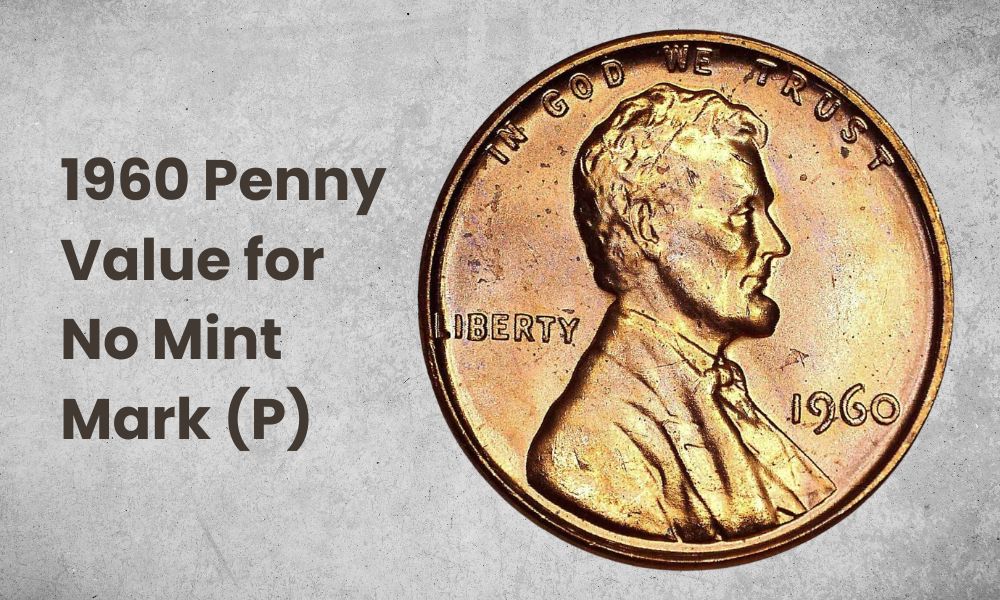
- Type: Lincoln Memorial Cents
- Edge: Plain
- Mint mark: No mint mark (P)
- Place of minting: Philadelphia
- Year of minting: 1960
- Face value: $0.01
- $ price: $0.05 to $400
- Quantity produced: 586,405,000
- Obverse designer: Victor D. Brenner
- Reverse designer: Frank Gasparro
In 1960, almost 587 million pennies were minted in Philadelphia. That’s around 23 million less than the number produced the previous year, which was the inception year of the Lincoln Memorial cent.
Two varieties came out of the 1960 Philadelphia penny issue. One had a small date on the obverse, and the other had an enlarged date. Let’s take a look at the differences between these two varieties.
Small Date Variety
In 1960, the US Mint noticed that the tiny “hole” in the number 0 of the penny’s date was prone to breakage and being filled in with a die chip. After producing a sizable amount of coins, the master die was changed completely—this time to one with larger digits for the date.
The 1960 (P) penny with the small date is much scarcer than the large date variety. It’s also rarer than the small date coin minted in Denver, making it the most valuable variety of the 1960 penny.
It’s so rare that no estimate exists for the current value of a 1960 (P) penny with a small date in circulated condition. In MS Brown, a Philly-minted penny can be valued between $1 (MS60) and $14 (MS66). In MS Red Brown, the price ranges from $7.50 (MS63) to $20 (MS66).
Surprisingly, the 1960 (P) penny is still quite common in collections in MS Red—specifically in grades MS65 and MS66. The former is valued at around $20, while the latter can be sold for $30. At a very high grade of MS67, you can expect an MS Red 1960 (P) penny to sell for around $400.
Large Date Variety
More 1960 (P) pennies were minted with a large date, making them a bit less valuable than their small date counterparts.
These coins are so common that the price is the same across almost all circulated grades. A PO1 and AU58 1960 (P) penny with a large date are both valued at around $0.05 today. The price only changes when a coin is graded AU58+, putting its value at $0.10.
In MS Brown and Red Brown, mint-state coins in this issue can cost between $0.10 and $20, depending on their color and condition.
Just like the small date variety, the large date coin is common in MS Red. They’re plentiful in mint-state grades, particularly MS64 through MS67. The better the condition, the more valuable the coin. At MS67, a 1960 (P) penny with a large date can cost around $345.
1960 Penny Value for “D” Mint Mark
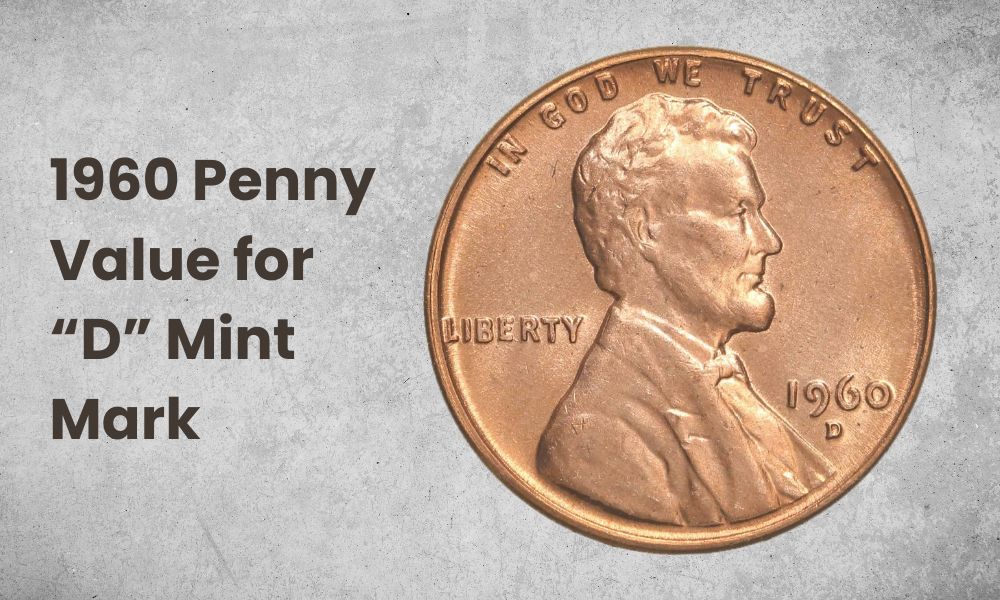
- Type: Lincoln Memorial Cents
- Edge: Plain
- Mint mark: D
- Place of minting: Denver
- Year of minting: 1960
- Face value: $0.01
- $ price: $0.05 to $345
- Quantity produced: 1,580,884,000
- Obverse designer: Victor D. Brenner
- Reverse designer: Frank Gasparro
Denver minted triple the number of pennies Philadelphia did in 1960. It produced 1.58 billion coins. Because there were three times more coins made in Denver, the price of these coins is a bit lower compared to their Philadelphia-born cousins.
Just like the Philly issue, the Denver one came in two varieties—small and large dates.
Small Date Variety
Even if the Denver coins are way more common than the Philadelphia pennies of 1960, their prices are quite similar. To be specific, the value of a 1960 D penny with a small date pretty much mirrors the value of a 1960 (P) penny with a large date in almost all grades.
In all circulated conditions, a 1960 D penny with a small date is valued at $0.05. In mint-state conditions, the value can go up to around $12.50 for MS Brown and $75 for MS Red Brown.
As expected, this variety is most preserved in MS Red. You’ll find it in mint-state grades, specifically in MS64, MS65, and MS66. These grades can give your coin values of $12.50, $20, and $30, respectively. At a lustrous grade of MS67, you can sell your 1960 D penny with a small date for $300.
Large Date Variety
The 1960 D penny with a large date is arguably the least valuable variety because it’s the least scarce. In MS Brown, the value of this variety doesn’t hit the one-dollar mark until MS64, which is a high grade already. At MS67, an MS Brown coin can be valued at $7.50.
Of course, the prices of these circulated coins can go higher if there are mint errors. For example, an MS Brown, AU58 coin in this variety is only $0.05. But with a small date over a large date error (which we’ll discuss later), it can be sold for almost $60.
MS Red Brown coins aren’t so typical for this variety. Only a few exist between the grades of MS63 and MS66. These coins can be valued between $2.50 to $15.
This variety is most common in fully Red gems, specifically in MS65 and MS66. At MS65, an MS Red coin can be valued at $15. This price doubles at grade MS66, raising the value to $30. There are also a handful of MS67, fully Red coins out there, valued at around $265.
History of the 1960 Penny
Victor Brenner’s Lincoln wheat penny was famously known for being struck to commemorate Lincoln’s 100th birth anniversary. And on the 150th of this occasion in 1959, the reverse of the cent was upgraded to show the Lincoln Memorial.
The design of the new reverse was done by the US Mint’s assistant graver, Frank Gasparro. When it was distributed to the public, people were surprised. No news had leaked of this new design.
There were mixed reactions among coin lovers and the public. It is said that Gasparro never visited the Lincoln Memorial while designing the cent’s reverse. Some people say you can tell that’s the case, even comparing the look of the monument to a trolley cart.
In 1960, the Philadelphia and Denver Mints both had issues about how the dates were struck on the penny. So, each issue has small and large date varieties.
It was the first year to have these date varieties. It would later come back up again in 1970 when the same problem with the numeral 0 was to be discovered.
The Lincoln Memorial penny would see many changes in its composition, from the deletion of tin in 1962 to the switch to aluminum in 1974. Of course, the latter did not work because its radiodensity made it undetectable if ingested by a human.
Finally, in 1982, the composition would be changed to 97.5% copper and 2.5% zinc—the composition of the cent today.
1960 Penny Grading
Grading the Lincoln Memorial pennies can be a taxing job for novice collectors. Essentially, a 1960 penny that is worn and looks quite brown is a circulated coin. It is bound to be worth a small amount only.
Meanwhile, a red, lustrous coin with high eye appeal will likely be uncirculated. These coins are worth more than just one cent, especially in grades MS67 and MS68.
The most valuable 1960 pennies are those in grades MS67 and MS68. However, they’re very difficult to grade. Check out this video to learn how to do it properly:
1960 Penny Errors
1. 1960 Penny Doubled Die Obverse with D/D Error
A combination of a doubled die obverse and repunched D mint mark has been found in a Denver-minted 1960 penny. Not only does it have a doubled date because of a faulty master die, but it also has two Ds struck where the mint mark should be.
This remarkable coin will surely be an asset to any collector who loves mint errors.
2. 1960 Penny Large Date Over Small Date Error
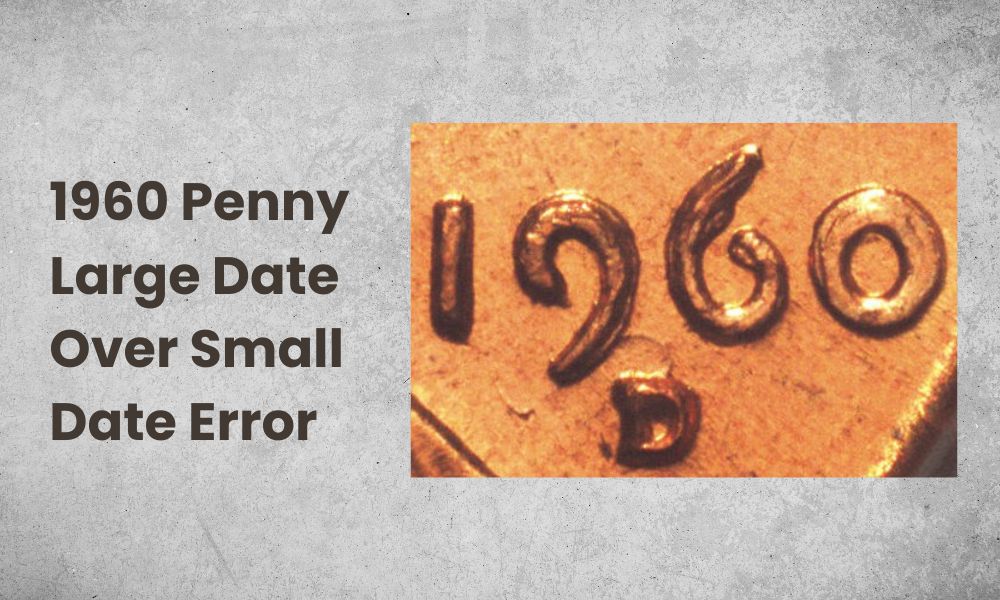
Another common error among the 1960 pennies is a large date punched on top of a small date. This might have been an attempt to fix the issue of the small date earlier in the production.
A 1960 penny with this error is incredibly valuable. An MS65, fully Red coin with this error can be sold for over $375. Meanwhile, an MS66, fully Red coin can sell for $4,000.
Learn more about the tricky varieties and errors to watch out for in the 1960 pennies with this video:
1960 Penny FAQs
How can you tell if a 1960 penny is a small date?
You can easily tell if your 1960 penny is a small date by looking at the alignment of the numbers on the date. In a large date coin, the top of the 9 will be higher than that of the 1. But on a small date variety, the tops of both numbers will be aligned.
Is a 1960 penny rare?
Technically, 1960 pennies aren’t rare because they were plentiful in production. So, you might find many 1960 pennies in your coin purse even today. However, its varieties, mint errors, and color grades can increase the rarity of a specific 1960 coin, making it more valuable.
What were pennies made of in 1960?
Pennies back then were made of 95% copper and 5% tin and zinc. It’s quite different from today’s penny, which is made of copper-plated zinc.
Is there a 1960 silver penny?
No, pennies in 1960 were made of copper, tin, and zinc. There is no known record of a 1960 penny struck on a silver planchet by mistake in any mint.
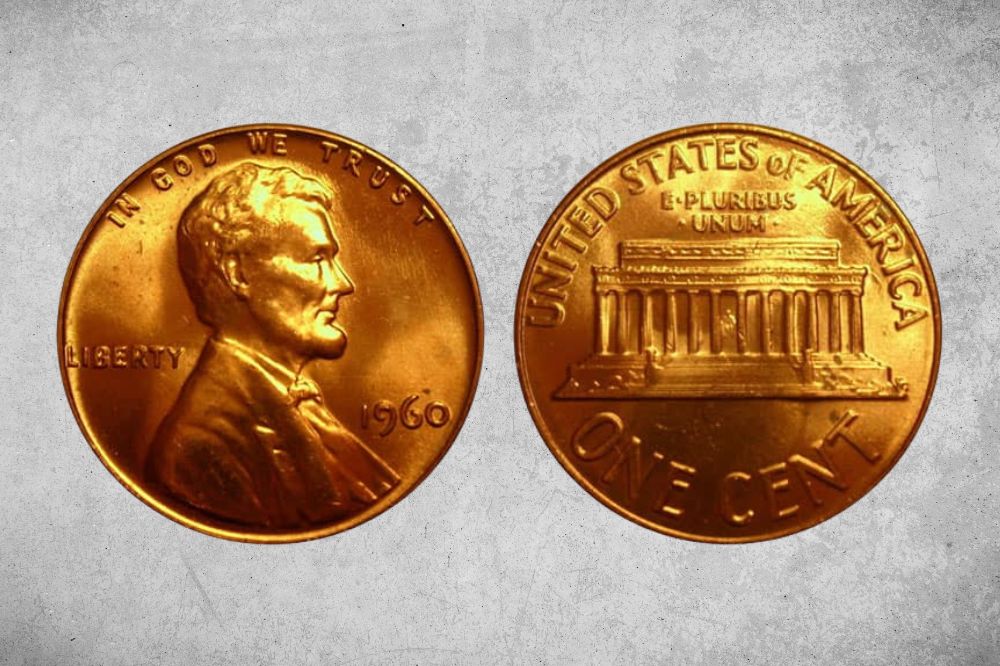
I have a 1960 no mint wheat still red small date weighs 3.05 with L touching edge WE touching MATTO error in face no intials VBL on front and a 1959 D all the same except it weighs 3.11
I just recently found a 1960 no mint mark penny with a chunk taken out of the top amd the reverse is the Lincoln memorial what is it ..?